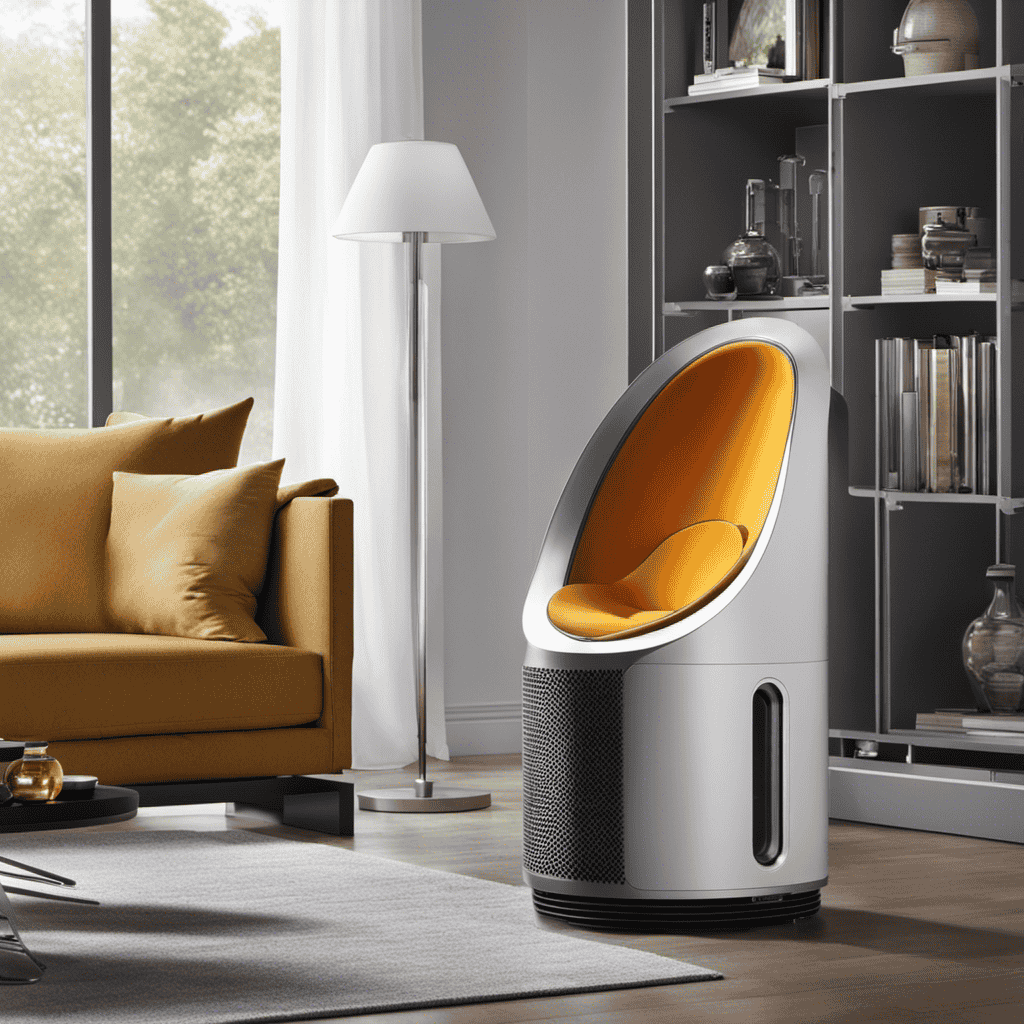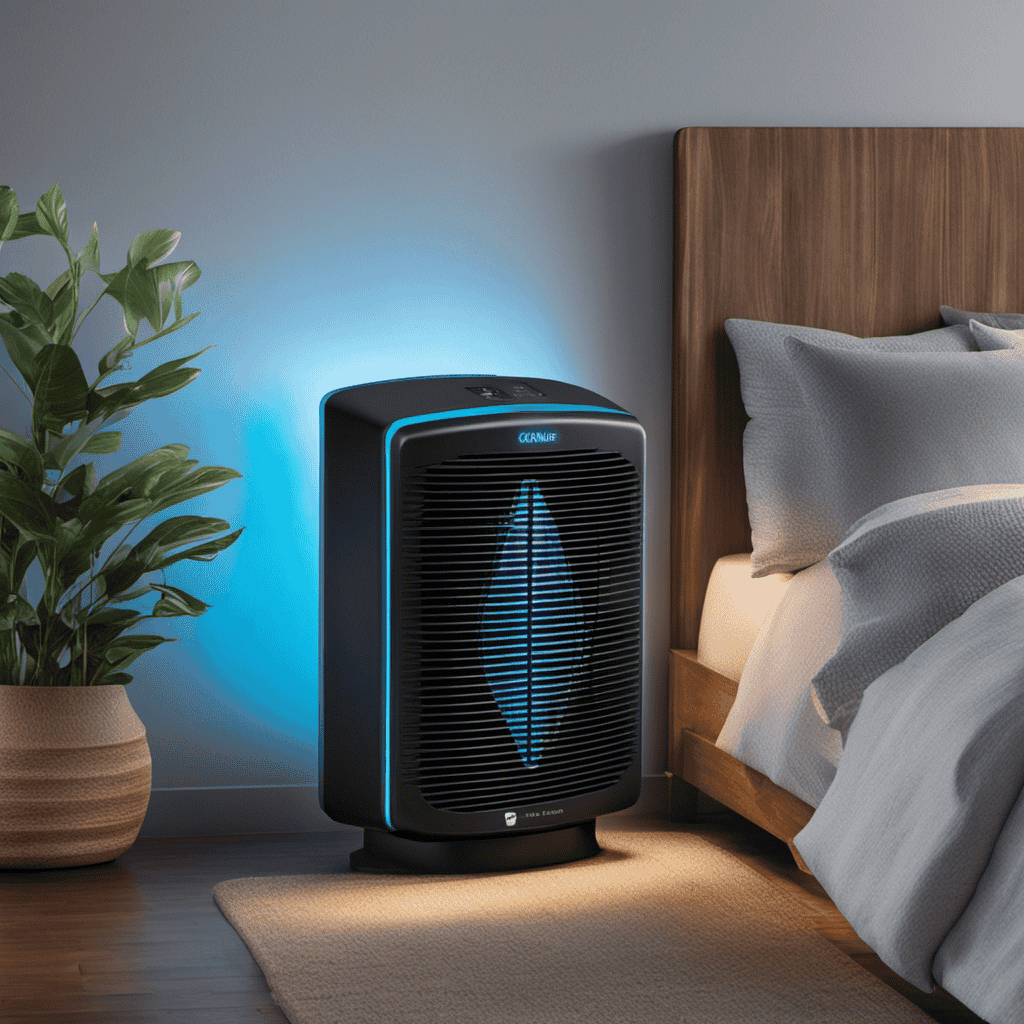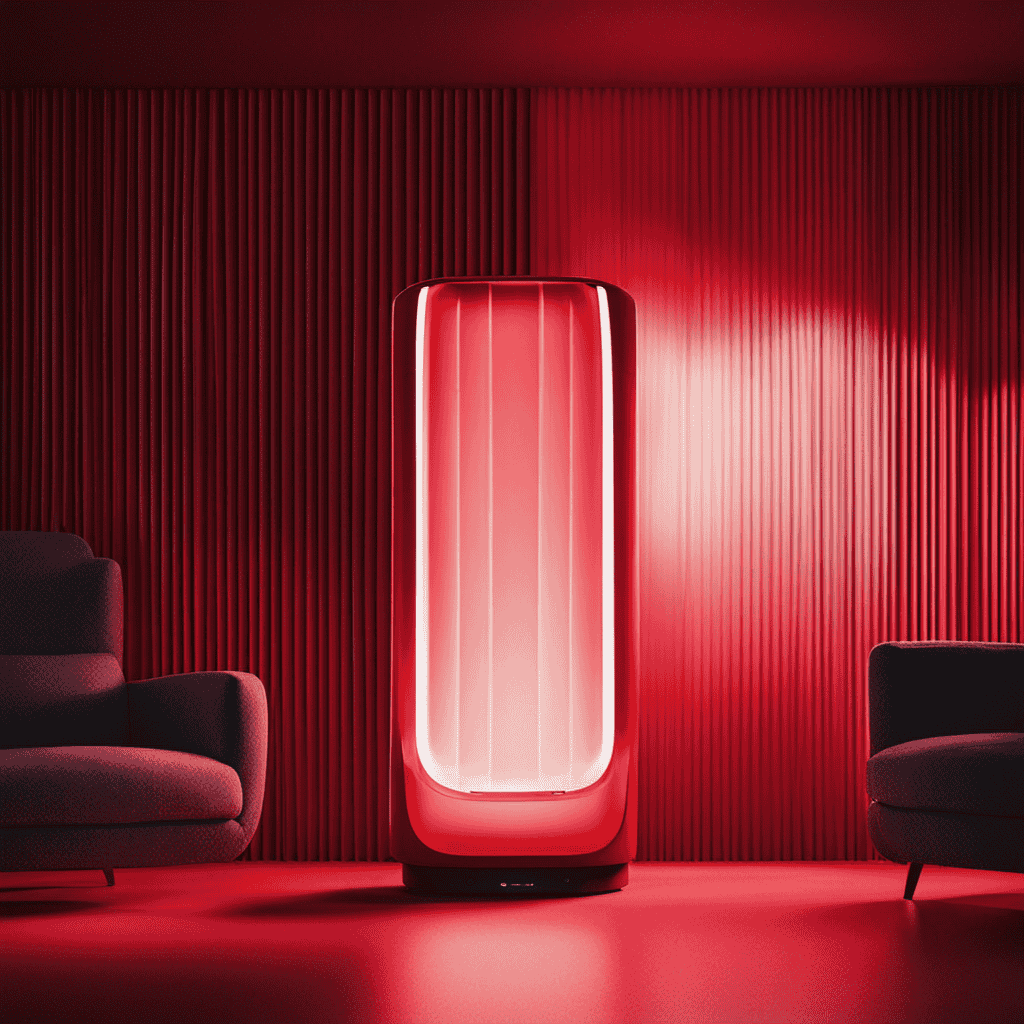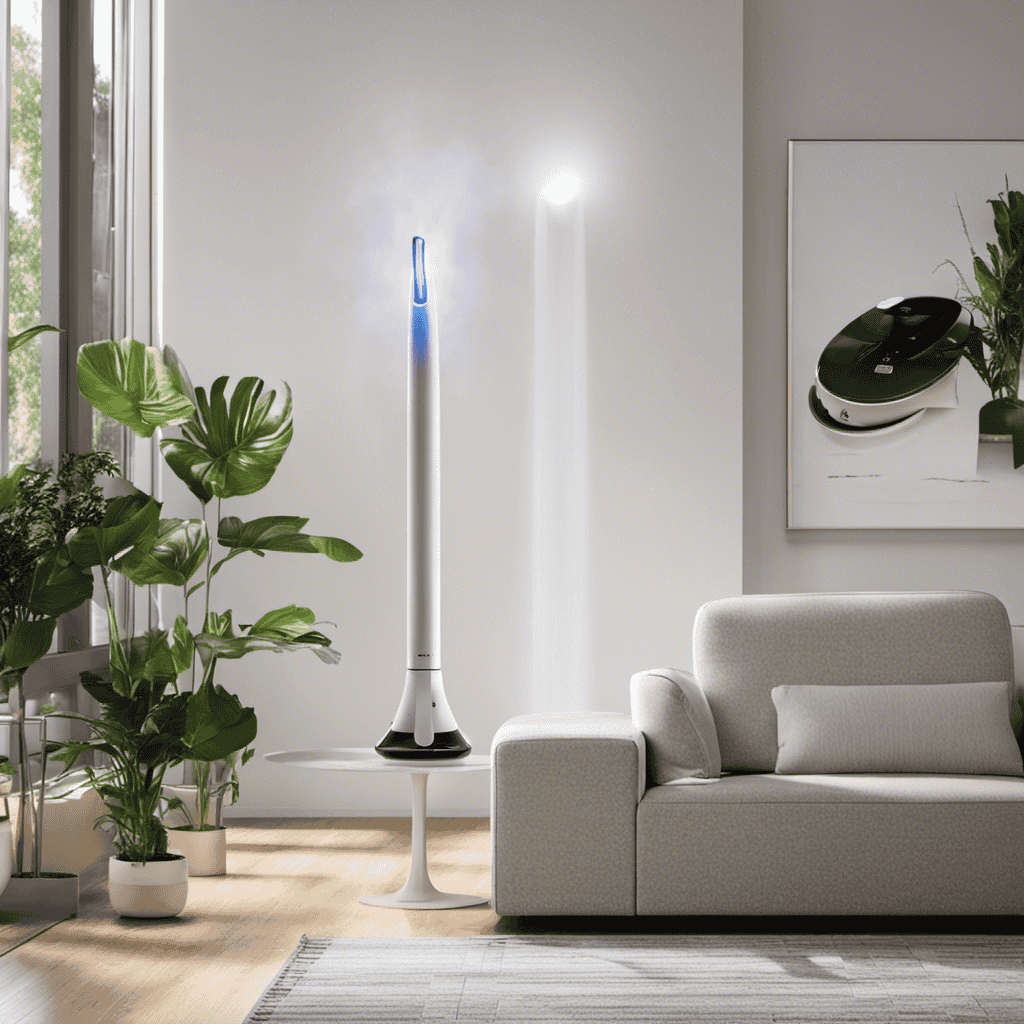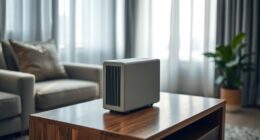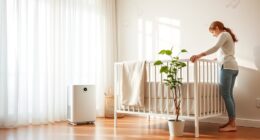I have been impressed by the Dyson air purifier’s capability to create a clean and fresh atmosphere in my home, as a satisfied owner.
But have you ever wondered how this innovative device actually works? In this article, we will delve into the intricate technology behind Dyson air purifiers, exploring their filtration system, allergen and pollutant removal capabilities, role of sensors, and the unique Air Multiplier technology.
Join me on this scientific journey as we unravel the secrets of how a Dyson air purifier works.
Key Takeaways
- Dyson air purifiers use advanced filters and airflow engineering to improve indoor air quality.
- The filtration system includes a HEPA filter for capturing small particles, activated carbon filters for removing gases and odors, and a pre-filter for capturing larger particles like dust and pet hair.
- Sensors in Dyson air purifiers detect and monitor air quality, allowing the purifier to adapt its settings for maximum effectiveness.
- Air multiplier technology enhances airflow and purification efficiency, providing increased coverage and ensuring a healthier living environment.
The Technology Behind Dyson Air Purifiers
To understand how a Dyson air purifier works, you’ll want to know about the technology behind it.
Dyson air purification technology is designed to maximize air purifier efficiency and ensure clean and healthy air in your environment. The core technology used in Dyson air purifiers is a combination of advanced filters and airflow engineering.
The filters include a HEPA filter that can capture particles as small as 0.3 microns, including allergens, bacteria, and viruses. Additionally, Dyson air purifiers use activated carbon filters to remove gases and odors.
The airflow engineering aspect involves the use of a powerful motor and a specially designed fan that circulates the air efficiently, drawing in pollutants and pushing out clean air.
This technology ensures that Dyson air purifiers effectively clean the air in your space, providing you with fresh and purified air to breathe.
Understanding the Filtration System of Dyson Air Purifiers
Understanding how the filtration system in Dyson air purifiers functions can help you make informed decisions about maintaining clean indoor air. The filtration process of Dyson air purifiers consists of multiple stages, each designed to capture and remove different types of airborne pollutants.
| Filtration Stage | Description |
|---|---|
| Pre-filter | Captures larger particles like dust and pet hair. |
| Activated Carbon Filter | Eliminates odors and volatile organic compounds (VOCs). |
| HEPA Filter | Traps 99.97% of microscopic particles as small as 0.3 microns, including pollen, mold spores, and bacteria. |
| Final Layer Filter | Removes ultrafine particles, such as allergens and viruses, with a size down to 0.1 microns. |
Dyson air purifiers are designed to maximize purification efficiency by utilizing a combination of these filters. The HEPA filter, in particular, plays a crucial role in removing the majority of airborne pollutants. It’s important to regularly clean and replace the filters to maintain the purifier’s performance. By understanding the filtration process and ensuring proper maintenance, you can enjoy cleaner and healthier indoor air.
How Dyson Air Purifiers Remove Allergens and Pollutants
By utilizing a combination of filters, Dyson air purifiers effectively remove allergens and pollutants from indoor air. These pollutants, such as dust, pet dander, pollen, and volatile organic compounds (VOCs), can have a significant impact on respiratory health. When we breathe in these particles, they can irritate the airways and trigger allergies or worsen existing respiratory conditions.
Dyson air purifiers tackle this problem by using a HEPA filter to capture particles as small as 0.3 microns, including allergens and fine dust. Additionally, they employ an activated carbon filter to capture harmful VOCs and odors. This comprehensive filtration system ensures that the indoor air quality is greatly improved, providing a healthier environment for everyone.
Now, let’s explore the role of sensors in Dyson air purifiers.
The Role of Sensors in Dyson Air Purifiers
When using a Dyson air purifier, sensors play a crucial role in detecting and monitoring the air quality in your home. These sensors are equipped with advanced technology that allows them to analyze the air and provide accurate readings. The effectiveness of sensor technology in Dyson air purifiers can be seen in the way it continuously monitors the air and adjusts the purification settings accordingly. The sensors detect various pollutants such as allergens, dust, and volatile organic compounds (VOCs), ensuring that the air purifier effectively targets and removes these contaminants.
To give you a better understanding of the role of sensors, here is a table highlighting the different sensors used in Dyson air purifiers and their functions:
| Sensor | Function |
|---|---|
| Particle Sensor | Detects and measures the concentration of particles in the air, such as dust, pollen, and pet dander. |
| Gas Sensor | Identifies and measures the presence of volatile organic compounds (VOCs) and gases that could be harmful to health. |
| Humidity and Temperature Sensor | Monitors and adjusts the humidity and temperature levels in the room for optimal air quality. |
These sensors work together to provide real-time data on the air quality, allowing the air purifier to adapt its purification settings for maximum effectiveness. With the help of these sensors, Dyson air purifiers ensure that you and your loved ones breathe clean and healthy air.
Now let’s explore the fascinating air multiplier technology in Dyson air purifiers.
Exploring the Air Multiplier Technology in Dyson Air Purifiers
Air Amplification Mechanics Explained:
In this discussion, I will delve into the intricate mechanics behind air amplification in Dyson Air Purifiers. By understanding how this technology works, we can gain insights into its effectiveness in providing clean, purified air.
Benefits of Air Multiplication:
Furthermore, I will explore the numerous benefits of air multiplication in Dyson Air Purifiers. This innovative feature not only enhances the airflow but also improves the overall performance of the purifier, ensuring a healthier living environment.
Through a technical and scientific lens, we will uncover the inner workings of air amplification and discover the advantages it brings to the table, making Dyson Air Purifiers stand out in the market.
Air Amplification Mechanics Explained
To understand how a Dyson air purifier works, you’ll be amazed by the air amplification mechanics it utilizes. The air amplification technology in Dyson air purifiers is designed to enhance the airflow and improve the efficiency of the purification process. Here’s how it works:
-
Multiplier Effect: The air amplification technology in Dyson purifiers uses a unique bladeless fan design to create a powerful airflow. It draws in air from the surroundings and then accelerates it using a high-velocity jet of air.
-
Coanda Effect: As the accelerated air is released, it adheres to the curved surface of the air purifier. This phenomenon, known as the Coanda effect, causes the air to follow the contours of the purifier, resulting in a more consistent and evenly distributed airflow.
-
Increased Coverage: The air amplification mechanics allow Dyson purifiers to cover a larger area with purified air. By amplifying the airflow, the purifier can effectively circulate clean air throughout the room, reducing the presence of pollutants.
-
Enhanced Efficiency: The air amplification technology not only improves the coverage but also enhances the efficiency of the purification process. By increasing the airflow, the purifier can capture and remove more pollutants from the air, providing better air quality for a healthier living environment.
Understanding the air amplification technology in Dyson air purifiers is crucial for appreciating the benefits it brings, including improved air quality, increased coverage, and enhanced efficiency.
Benefits of Air Multiplication
Now that we understand the mechanics behind air amplification, let’s explore the benefits it brings to air circulation and indoor air quality.
The Dyson air purifier’s ability to multiply the airflow provides several advantages. Firstly, it enhances the distribution of purified air throughout the room, reaching every corner effectively. This ensures that no stagnant areas are left untouched, resulting in improved overall air quality.
Secondly, the increased airflow helps in maintaining a consistent temperature, preventing hot or cold spots within the room.
Lastly, the amplified air circulation helps in reducing the concentration of airborne pollutants, such as allergens, dust, and pet dander, thereby enhancing the indoor air quality.
With a better understanding of the benefits of air multiplication, let’s now delve into the important topic of maintaining and cleaning your Dyson air purifier.
Maintaining and Cleaning Your Dyson Air Purifier
Regularly cleaning and maintaining your Dyson air purifier is essential for optimal performance. To maintain efficiency and ensure clean air, follow these cleaning techniques:
-
Filter maintenance: Clean or replace the air filters regularly. Dyson recommends washing the filters once a month under cold water until the water runs clear. Allow the filters to dry completely before reinstalling them.
-
Exterior cleaning: Wipe the exterior of the purifier with a soft, damp cloth. Avoid using harsh chemicals or abrasive materials that can damage the surface.
-
Ventilation cleaning: Use a soft brush or vacuum attachment to remove dust and debris from the air vents. This helps to maintain proper airflow and prevent blockages.
-
Deep cleaning: Periodically, perform a deep clean by disassembling the purifier and cleaning each component individually following the manufacturer’s instructions.
Frequently Asked Questions
How Much Electricity Does a Dyson Air Purifier Consume?
A Dyson air purifier consumes a moderate amount of electricity due to its powerful filtration system and fan. However, it is designed to be energy efficient, using advanced technology to maximize performance while minimizing energy consumption.
Can Dyson Air Purifiers Eliminate Cigarette Smoke?
Yes, a Dyson air purifier can effectively eliminate cigarette smoke by filtering indoor pollutants and odors. Its advanced filtration system captures smoke particles, ensuring cleaner and fresher air.
Are Dyson Air Purifiers Effective in Reducing Pet Dander?
Yes, Dyson air purifiers are effective in reducing pet dander compared to other brands. However, they do require frequent filter changes to maintain optimal performance and continue removing pet dander effectively.
Can Dyson Air Purifiers Remove Viruses and Bacteria From the Air?
Yes, Dyson air purifiers can remove viruses and bacteria from the air. They use a combination of filters to capture allergens, pollen, and even microscopic particles. Additionally, Dyson offers a warranty for their air purifiers.
Are Dyson Air Purifiers Noisy When Operating?
Yes, Dyson air purifiers can be noisy when operating, but the noise level varies depending on the model. According to customer reviews, some models are quieter than others, so it’s important to consider this when choosing a Dyson air purifier.
Can an Electromagnetic Air Purifier Work as Effectively as a Dyson Air Purifier?
When it comes to electromagnetic air purifier workings, there is debate about their effectiveness compared to Dyson air purifiers. While both use advanced technology to clean the air, some argue that Dyson’s patented HEPA filtration system makes it more efficient. However, electromagnetic purifiers have their own unique advantages.
Conclusion
In conclusion, the Dyson Air Purifier is a remarkable device that employs cutting-edge technology to ensure clean and fresh air in your surroundings. With its efficient filtration system, it acts as a shield against allergens and pollutants, providing a breath of fresh air.
The sensors play a crucial role in monitoring and adjusting the settings, ensuring optimal performance. And just like a gentle breeze, the Air Multiplier technology distributes purified air evenly throughout the room.
Remember, regular maintenance and cleaning are essential to keep your Dyson Air Purifier running smoothly, just like maintaining a well-oiled machine.
